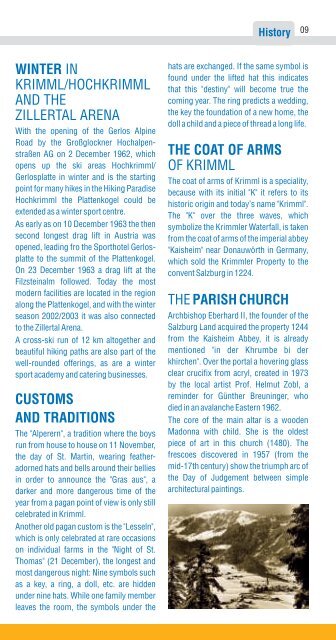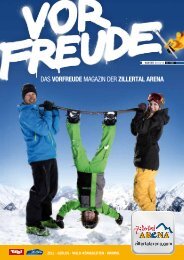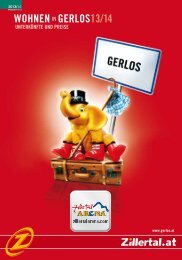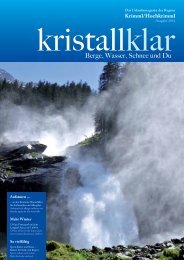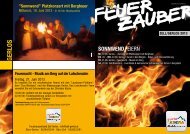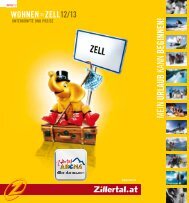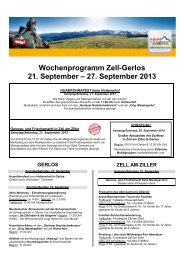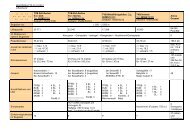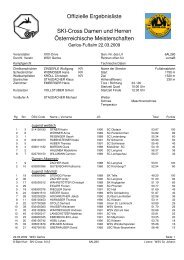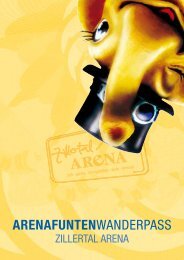Krimml INFO Winter 2013-14.cdr - Zillertal Arena
Krimml INFO Winter 2013-14.cdr - Zillertal Arena
Krimml INFO Winter 2013-14.cdr - Zillertal Arena
Erfolgreiche ePaper selbst erstellen
Machen Sie aus Ihren PDF Publikationen ein blätterbares Flipbook mit unserer einzigartigen Google optimierten e-Paper Software.
History<br />
09<br />
WINTER IN<br />
KRIMML/HOCHKRIMML<br />
AND THE<br />
ZILLERTAL ARENA<br />
With the opening of the Gerlos Alpine<br />
Road by the Großglockner Hochalpenstraßen<br />
AG on 2 December 1962, which<br />
opens up the ski areas Hochkrimml/<br />
Gerlosplatte in winter and is the starting<br />
point for many hikes in the Hiking Paradise<br />
Hochkrimml the Plattenkogel could be<br />
extended as a winter sport centre.<br />
As early as on 10 December 1963 the then<br />
second longest drag lift in Austria was<br />
opened, leading fro the Sporthotel Gerlosplatte<br />
to the summit of the Plattenkogel.<br />
On 23 December 1963 a drag lift at the<br />
Filzsteinalm followed. Today the most<br />
modern facilities are located in the region<br />
along the Plattenkogel, and with the winter<br />
season 2002/2003 it was also connected<br />
to the <strong>Zillertal</strong> <strong>Arena</strong>.<br />
A cross-ski run of 12 km altogether and<br />
beautiful hiking paths are also part of the<br />
well-rounded offerings, as are a winter<br />
sport academy and catering businesses.<br />
CUSTOMS<br />
AND TRADITIONS<br />
The "Alperern", a tradition where the boys<br />
run from house to house on 11 November,<br />
the day of St. Martin, wearing featheradorned<br />
hats and bells around their bellies<br />
in order to announce the "Gras aus", a<br />
darker and more dangerous time of the<br />
year from a pagan point of view is only still<br />
celebrated in <strong>Krimml</strong>.<br />
Another old pagan custom is the "Lesseln",<br />
which is only celebrated at rare occasions<br />
on individual farms in the "Night of St.<br />
Thomas" (21 December), the longest and<br />
most dangerous night: Nine symbols such<br />
as a key, a ring, a doll, etc. are hidden<br />
under nine hats. While one family member<br />
leaves the room, the symbols under the<br />
hats are exchanged. If the same symbol is<br />
found under the lifted hat this indicates<br />
that this "destiny" will become true the<br />
coming year. The ring predicts a wedding,<br />
the key the foundation of a new home, the<br />
doll a child and a piece of thread a long life.<br />
THE COAT OF ARMS<br />
OF KRIMML<br />
The coat of arms of <strong>Krimml</strong> is a speciality,<br />
because with its initial "K" it refers to its<br />
historic origin and today's name "<strong>Krimml</strong>".<br />
The "K" over the three waves, which<br />
symbolize the <strong>Krimml</strong>er Waterfall, is taken<br />
from the coat of arms of the imperial abbey<br />
"Kaisheim" near Donauwörth in Germany,<br />
which sold the <strong>Krimml</strong>er Property to the<br />
convent Salzburg in 1224.<br />
THE PARISH CHURCH<br />
Archbishop Eberhard II, the founder of the<br />
Salzburg Land acquired the property 1244<br />
from the Kaisheim Abbey, it is already<br />
mentioned "in der Khrumbe bi der<br />
khirchen". Over the portal a hovering glass<br />
clear crucifix from acryl, created in 1973<br />
by the local artist Prof. Helmut Zobl, a<br />
reminder for Günther Breuninger, who<br />
died in an avalanche Eastern 1962.<br />
The core of the main altar is a wooden<br />
Madonna with child. She is the oldest<br />
piece of art in this church (1480). The<br />
frescoes discovered in 1957 (from the<br />
mid-17th century) show the triumph arc of<br />
the Day of Judgement between simple<br />
architectural paintings.


